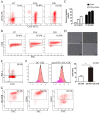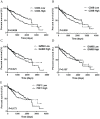Blocking the PD-1/PD-L1 axis in dendritic cell-stimulated Cytokine-Induced Killer Cells with pembrolizumab enhances their therapeutic effects against hepatocellular carcinoma
- PMID: 31258764
- PMCID: PMC6584335
- DOI: 10.7150/jca.26961
Blocking the PD-1/PD-L1 axis in dendritic cell-stimulated Cytokine-Induced Killer Cells with pembrolizumab enhances their therapeutic effects against hepatocellular carcinoma
Abstract
Immune checkpoint therapies for cancer, like the anti-programmed cell death 1 (PD-1) agent pembrolizumab, have gained considerable attention. However, the use of immune checkpoint inhibitors in the context of adoptive immunotherapy is poorly characterized. We investigated the therapeutic efficacy of dendritic cell-stimulated CIK (DC-CIK) cells pretreated with pembrolizumab against hepatocellular carcinoma (HCC) in cytotoxicity assay in vitro and in a nude mouse xenograft model. We used time-lapse imaging to investigate tumor killing. We also performed a survival analysis based on lymphocyte subpopulation-specific mRNA signatures using The Cancer Genome Atlas (TCGA) HCC cohort (n=371 patients). The results indicated that PD-1 inhibition increased the anti-tumor effects of DC-CIK cells over those of DC-CIK cells alone, resulting in a survival benefit importantly. Time-lapse imaging revealed that DC-CIK cells appeared to be more effective and aggressive after anti-PD-1 treatment than after culture in control conditions. The PD-1 inhibitor also induced more effective immune cell infiltration of the tumor. Our analysis of the TCGA HCC cohort confirmed that a genetic signature consistent with a high degree of intratumoral CD8+ T cell infiltration is associated with good prognosis. These results suggest that blockade of the PD-1/PD-L1 axis in DC-CIK cells with a PD-1 inhibitor prior to infusion is a promising therapeutic strategy against HCC.
Keywords: PD-1; cytokine-induced killer cells; dendritic cells; hepatocellular carcinoma; immunotherapy.
Conflict of interest statement
Competing Interests: The authors have declared that no competing interest exists.
Figures





Similar articles
-
A prognosis and impact factor analysis of DC-CIK cell therapy for patients with hepatocellular carcinoma undergoing postoperative TACE.Cancer Biol Ther. 2018 Jun 3;19(6):475-483. doi: 10.1080/15384047.2018.1433501. Epub 2018 Mar 6. Cancer Biol Ther. 2018. PMID: 29400599 Free PMC article.
-
Implication of combined PD-L1/PD-1 blockade with cytokine-induced killer cells as a synergistic immunotherapy for gastrointestinal cancer.Oncotarget. 2016 Mar 1;7(9):10332-44. doi: 10.18632/oncotarget.7243. Oncotarget. 2016. PMID: 26871284 Free PMC article.
-
Dendritic Cell Immunotherapy Combined with Cytokine-Induced Killer Cells Effectively Suppresses Established Hepatocellular Carcinomas in Mice.Immunol Invest. 2016 Aug;45(6):553-65. doi: 10.1080/08820139.2016.1183025. Epub 2016 Jul 13. Immunol Invest. 2016. PMID: 27410037
-
Efficacy and safety of dendritic cells co-cultured with cytokine-induced killer cells immunotherapy for non-small-cell lung cancer.Int Immunopharmacol. 2015 Sep;28(1):22-8. doi: 10.1016/j.intimp.2015.05.021. Epub 2015 May 23. Int Immunopharmacol. 2015. PMID: 26013109 Review.
-
Effectiveness and safety of chemotherapy combined with cytokine-induced killer cell /dendritic cell-cytokine-induced killer cell therapy for treatment of gastric cancer in China: A systematic review and meta-analysis.Cytotherapy. 2016 Sep;18(9):1162-77. doi: 10.1016/j.jcyt.2016.05.015. Epub 2016 Jul 12. Cytotherapy. 2016. PMID: 27421742
Cited by
-
Monophosphoryl lipid A-induced activation of plasmacytoid dendritic cells enhances the anti-cancer effects of anti-PD-L1 antibodies.Cancer Immunol Immunother. 2021 Mar;70(3):689-700. doi: 10.1007/s00262-020-02715-4. Epub 2020 Sep 9. Cancer Immunol Immunother. 2021. PMID: 32902663 Free PMC article.
-
Neoadjuvant combination of pazopanib or axitinib and programmed cell death protein-1-activated dendritic cell-cytokine-induced killer cells immunotherapy may facilitate surgery in patients with renal cell carcinoma.Transl Androl Urol. 2021 May;10(5):2091-2102. doi: 10.21037/tau-21-406. Transl Androl Urol. 2021. PMID: 34159090 Free PMC article.
-
A CTLA-4 blocking strategy based on Nanoboby in dendritic cell-stimulated cytokine-induced killer cells enhances their anti-tumor effects.BMC Cancer. 2021 Sep 15;21(1):1029. doi: 10.1186/s12885-021-08732-5. BMC Cancer. 2021. PMID: 34525966 Free PMC article.
-
Advances of Tumorigenesis, Diagnosis at Early Stage, and Cellular Immunotherapy in Gastrointestinal Malignancies.Front Oncol. 2021 Aug 9;11:666340. doi: 10.3389/fonc.2021.666340. eCollection 2021. Front Oncol. 2021. PMID: 34434889 Free PMC article. Review.
-
The efficacy and safety of the combination of axitinib and pembrolizumab-activated autologous DC-CIK cell immunotherapy for patients with advanced renal cell carcinoma: a phase 2 study.Clin Transl Immunology. 2021 Mar 3;10(3):e1257. doi: 10.1002/cti2.1257. eCollection 2021. Clin Transl Immunology. 2021. PMID: 33717483 Free PMC article.
References
-
- Poon D, Anderson BO, Chen LT, Tanaka K, Lau WY, Van Cutsem E. et al. Management of hepatocellular carcinoma in Asia: consensus statement from the Asian Oncology Summit 2009. The Lancet Oncology. 2009;10:1111–8. - PubMed
-
- Bruix J, Qin S, Merle P, Granito A, Huang Y-H, Bodoky G. et al. Regorafenib for patients with hepatocellular carcinoma who progressed on sorafenib treatment (RESORCE): a randomised, double-blind, placebo-controlled, phase 3 trial. The Lancet. 2017;389:56–66. - PubMed
-
- Deng X, Nakamura Y. Cancer Precision Medicine: From Cancer Screening to Drug Selection and Personalized Immunotherapy. Trends Pharmacol Sci. 2017;38:15–24. - PubMed
-
- Barreira da Silva R, Laird ME, Yatim N, Fiette L, Ingersoll MA, Albert ML. Dipeptidylpeptidase 4 inhibition enhances lymphocyte trafficking, improving both naturally occurring tumor immunity and immunotherapy. Nat Immunol. 2015;16:850–8. - PubMed
LinkOut - more resources
Full Text Sources
Research Materials

